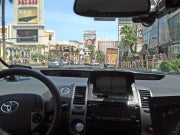Google's Self-Driving Car Licensed to Hit Nevada Streets
Google's self-driving car is growing up right in front of our eyes: The fledgling autonomous vehicle program recently passed its driver's license test in Nevada, the first license of its kind in the United States. Obtaining Nevada's self-driving car license clears the way for Google to test its technology on public roads in the state.
Google's modified Toyota Prius was given the thumbs up after successful test drives in Carson City and on the Las Vegas strip. Alongside the special license, Nevada also issued the car a unique set of red license plates that include the infinity symbol and the words “autonomous car.” With any luck, those plates should differentiate all the other vehicles on the road from Google’s car, which has cameras and radar equipment strapped to the roof.
 Nevada first began work on its autonomous vehicle licensing program last June when the state's lawmakers passed legislation toallow self-driving cars on public roads. In February, Nevada's Department of Motor Vehicles issued rules governing autonomous cars. The Nevada DMV rules currently limit the state's licensing to test vehicles; enthusiasts need not apply.
Nevada first began work on its autonomous vehicle licensing program last June when the state's lawmakers passed legislation toallow self-driving cars on public roads. In February, Nevada's Department of Motor Vehicles issued rules governing autonomous cars. The Nevada DMV rules currently limit the state's licensing to test vehicles; enthusiasts need not apply.To be approved for road travel, autonomous cars must have a combined minimum driving time of 10,000 miles. Nevada also requires autonomous car operators to submit a complete description of their self-driving technology, a detailed safety plan, and a plan for hiring and training test drivers. The state requires a $100 licensing fee plus $13 for each set of license plates, but companies must also purchase a surety bond of $1 million to put up to 5 vehicles on the road. Nevada says a number of other unnamed companies are looking to follow Google and test self-driving cars on the state's public roads.
Despite allowing only beta cars at the moment, Nevada is looking toward a day when self-driving cars will be sold to the public. The state's DMV says it plans to issue privately owned self-driving cars a green license plate that will also include the infinity symbol. Motorists will also be required to obtain a special driver license endorsement before they can get behind the wheel of future robotic cars.


























